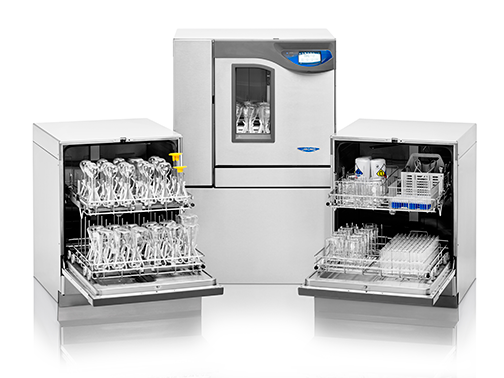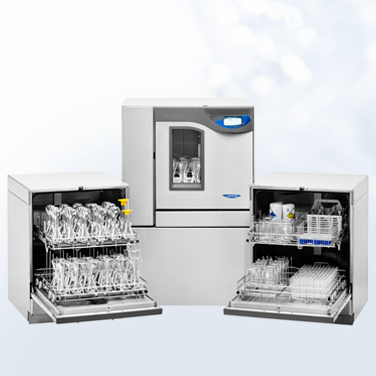Wash Away Worry with an Automated Glassware Washer
By Jordan Henderson, Product Manager, Labconco
Today’s laboratories require a steady supply of clean labware to operate efficiently. While cleaning glassware, plasticware, and other utensils is a relatively mundane task, it can have an enormous impact on the quality, accuracy, and precision of your lab’s results.
Washing glassware by hand is common in many laboratories, but it inherently varies from person to person, which can cost your lab time, energy, and money if it negatively impacts your results. Automated glassware washers, on the other hand, can help you more consistently meet cleanliness goals for your labware.
Automated washers come with a variety of features, so find one that offers the efficiency, versatility, and reliability you need.
Efficiency
Glassware, plasticware, and utensils often require different methods of washing and rinsing. Whether your labware needs robust cleaning from consistent, efficient spray arms or more targeted cleaning from direct injection washing and rinsing with spindles, your glassware washer should be able to easily accommodate whatever approach best suits your laboratory.
Your washer should also provide sufficient water temperature to adequately clean your labware. Some glassware washers may heat water to a maximum temperature of only 70°C (158°F) and lack the ability to tackle the boiled, baked, and caked-on contaminants many labs see every day. Wash and rinse water temperature minimums of 93°C (199°F) soften and penetrate stubborn contaminants while providing thermal disinfection, further reducing potential carryover from one wash cycle to the next.
It’s also important to find a washer that can keep up with high demand without sacrificing performance or cleaning ability. Choose a washer that’s intentionally designed to do more in less time with fewer resources. For example, the time it takes a washer to heat wash and rinse water directly affects the length of wash programs. A washer that allows you to choose between single-phase and three-phase heating options can provide more robust heating for the shortest, most efficient wash cycles.
Because automated glassware washers are far more consistent than hand washing, they can also help you standardize consumption of resources like water and electricity — they can even help you save time and money. Implementing an automatic glassware washer will consistently provide an excellent level of glassware cleanliness from the first cycle to the last, helping you avoid the negative impact that dirty labware can have on results.
Versatility
Rack flexibility is key when assessing your glassware washer. Glassware and plasticware come in all shapes and sizes, and your washer racks should be flexible enough to tackle whatever combination of labware you throw at them. When selecting a washer, look for useful features like adjustable rack positions, removable components, and overall functionality with available inserts, like those that hold test tubes or trays.
Need to wash vials, pipettes, or other pieces of specialized glassware? Glassware washer accessories should complement not only the washer but also your atypical, difficult-to-clean flasks, pipettes, and other specialty glassware.

The user interface is also an important consideration. It should deliver an intuitive experience that allows a user to tailor wash programs for specific workflows. Some washers even offer onboard data logging, storage, and export via USB or a secured network connection, which can help you validate custom wash programs.
Reliability
Water quality can vary from region to region, so using pure-water rinses is a great way to further ensure that your labware is clean. Water qualities such as hardness and pH level, as well as the presence of silica, metals, chloride, or organic materials, can result in residues that have a significant impact on the quality of your results. However, pure-water pumps aren’t standard on all automated glassware washers. Be sure to check for this — it can save you the headache of upgrading your current system or installing a new water purification system if the need for pure water rinses arises in the future.
The longevity and durability of a washer depends on the quality of its internal components. Underpowered components result in underpowered washers. When selecting a washer, be sure it uses robust pumps and quality valves and internal assemblies to minimize unscheduled down times.
In the unlikely event of mechanical issues, you should be able to quickly assess and identify component failures. A standard array of diagnostic tests can help identify potential component failures, and a warranty and post-installation support can help you quickly complete repairs. Similarly, support from knowledgeable service technicians can have a huge impact on getting your washer back up and running.
When considering an automated glassware washer, efficiency, versatility, and reliability should be standard on the model you choose. By focusing on these aspects, you can free scientists from the sink and help them get back to the lab.
| Description | Cat. No. |
|---|---|
| SteamScrubber, 115V, 60Hz, 1-Phase | 40-100-1000 |
| SteamScrubber, 208/230V, 50/60Hz, 1-Phase | 40-100-1010 |
| SteamScrubber, 208/230V, 50/60Hz, 3-Phase | 40-100-1013 |
| FlaskScrubber, 115V, 50/60Hz, 1-Phase | 41-100-1000 |
| FlaskScrubber, 208/230V, 50/60Hz, 1-Phase | 41-100-1010 |
| FlaskScrubber, 208/230V, 50/60Hz, 3-Phase | 41-100-1013 |
| FlaskScrubber Vantage, 208/230V, 50/60Hz, 1-Phase | 42-210-1010 |
| FlaskScrubber Vantage, 208/230V, 50/60Hz, 3-Phase | 42-210-1013 |

Content provided by:





